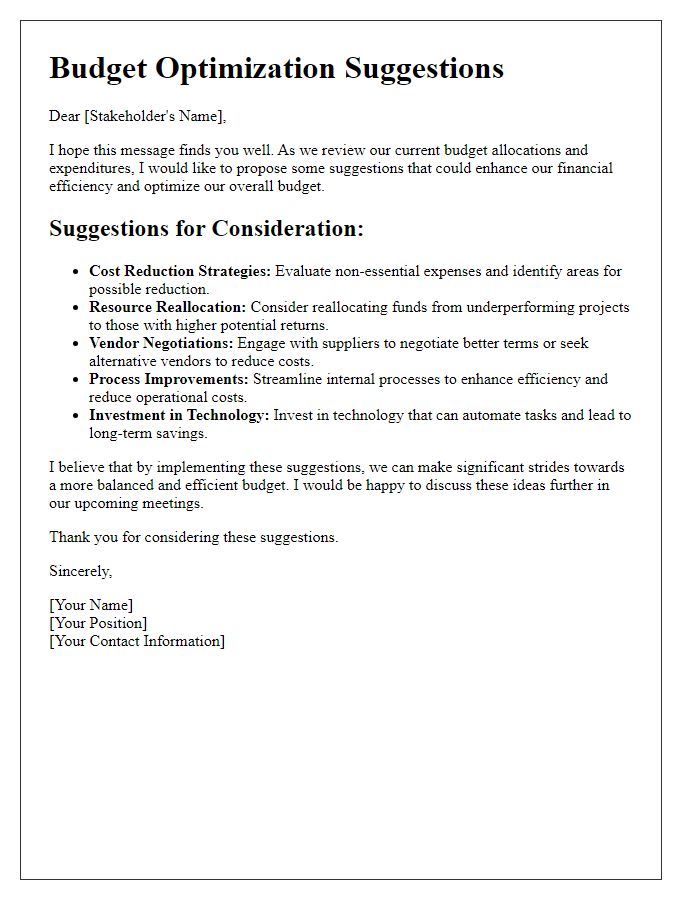Are you looking for ways to enhance your organization's efficiency and reduce expenses? In today's competitive landscape, incorporating cost-saving measures is essential for sustainable growth. By exploring innovative strategies and practices, we can improve our bottom line while maintaining the quality of our services. Join me as we delve deeper into these exciting proposals and discover how we can make a significant impact together.

Clear Objective Statement
Implementing cost-saving measures can significantly enhance operational efficiency within an organization. An analysis of monthly expenditures reveals that up to 20% of the budget is allocated to non-essential services, such as excessive office supplies and inefficient operating procedures. Streamlining procurement processes, negotiating with suppliers for bulk purchases, and embracing technology-driven solutions can lead to substantial savings. Benchmarking against industry standards shows that companies adopting these practices have reduced costs by an average of 15%, allowing for reinvestment into innovative projects and improved employee satisfaction.
Detailed Analysis of Current Costs
A detailed analysis of current costs within the manufacturing sector reveals significant opportunities for optimization. The annual operational expenditure, currently estimated at $2 million, includes various expense categories such as labor, raw materials, and overhead. Labor costs represent approximately 50% of total expenses, indicating potential for efficiency improvements through process automation and workforce training programs. Raw materials, accounting for around 30% of the budget, present opportunities for bulk purchasing agreements or alternative sourcing to reduce costs. Overhead, comprising utilities and facility maintenance, could be trimmed by adopting energy-efficient technologies and regular maintenance schedules. Implementing these cost-saving measures could ultimately yield a reduction of 10-15%, contributing to enhanced financial health and sustainability of the organization.
Specific Proposed Measures
In a corporate environment, implementing cost-saving measures can significantly enhance operational efficiency and profitability. For instance, adopting energy-efficient LED lighting can reduce electricity costs by up to 75%, with ROI realized within one to two years. Streamlining supply chain processes through automation software can decrease logistical expenses by an estimated 20%, while improving delivery times and inventory management. Additionally, promoting remote work policies, as seen with companies like Twitter, could lead to a reduction in real estate costs by eliminating the need for large office spaces. Furthermore, negotiating bulk purchasing agreements with suppliers has the potential to save upwards of 15% on material costs. Each of these measures not only contributes to immediate savings but also fosters a sustainable financial framework for future growth.
Anticipated Savings and Benefits
Implementing cost-saving measures, such as adopting energy-efficient technologies in corporate offices, can significantly reduce operational expenses. Transitioning to LED lighting, which consumes up to 75% less energy compared to traditional incandescent bulbs, can lead to annual savings upwards of $1,500 per building based on an average 10,000 square feet. Additionally, optimizing heating and cooling systems with smart thermostats can decrease energy use by an estimated 10-20%, potentially saving another $2,000 per year per unit. Further benefits include a lower carbon footprint, contributing to corporate sustainability goals, and improved employee morale through enhanced workplace comfort. Utilizing these strategies can lead to cumulative savings of over $100,000 for a medium-sized corporation over a five-year period while simultaneously boosting brand reputation as an environmentally responsible entity.
Call to Action with Next Steps
Proposing cost-saving measures can significantly enhance the financial health of an organization. For instance, implementing energy-efficient lighting systems (potentially reducing electricity costs by up to 30% annually) can lead to substantial savings over time. Likewise, investing in remote work technology (which can lower office supply expenses and reduce real estate costs) is increasingly relevant in today's digital landscape. Conducting an in-depth audit of current expenses (focusing on recurring monthly costs, which often inflate budgets) often reveals areas for potential reduction. Initiating employee training programs on cost-awareness behavior (as a way to cultivate a culture of financial responsibility) can also yield dividends. Encouraging participation in these initiatives (by clearly outlining the benefits of engagement) is critical for successful implementation and sustainability of these cost-saving strategies.
Letter Template For Proposing Cost-Saving Measures Samples
Letter template of expense reduction recommendations for the finance department

Letter template of fiscal responsibility actions for executive committee












Comments